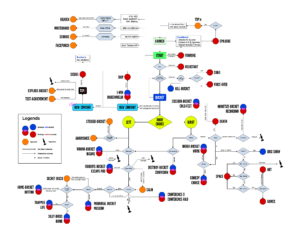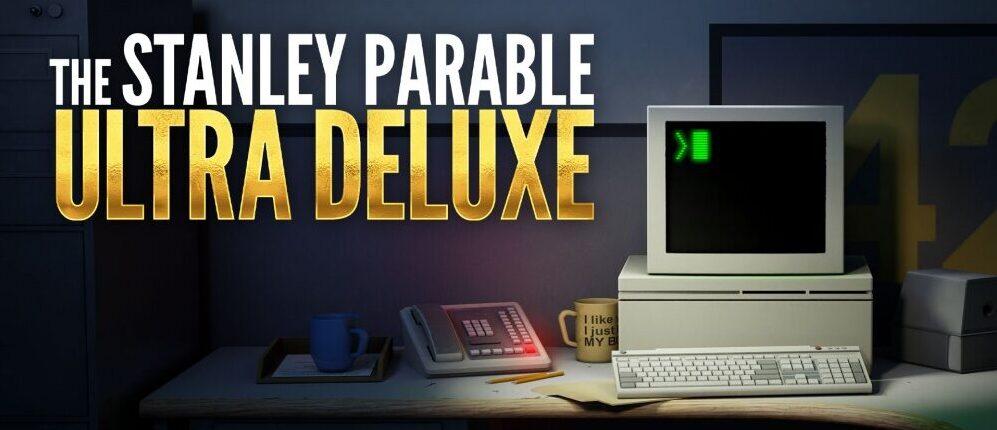About the Game
For this week’s assignment, I played The Stanley Parable: Ultra Deluxe, a game created by Davey Wreden and William Pugh in 2020. This game is an expanded edition of the original game, The Stanley Parable, which was released in 2013, and thus has the same gameplay as the first while adding in a plethora of new storylines, features, and endings. Both games have intellectual themes of free will, determinism, and the nature of choice, making the target demographic for this game a slightly older crowd (probably 15 and up) who enjoy philosophical games. With absolutely zero knowledge of the game coming into this, I played around two hours of it on my Mac after purchasing it through the Steam store.

[ the game takes place within an abandoned office building ]
Game Mechanics
The Stanley Parable: Ultra Deluxe is unlike other video games that I’ve played before in that it’s completely narrative-driven, with very little action required of the player. In fact, the only controls that the player has while in the game are the ability to walk forwards, backward, to the left, and to the right using the basic arrow keys, and occasionally the ability to click on an object such as a button or a lever. The game is also presented in a first-person perspective, so the player has the ability to move their mouse to direct where the character, Stanley, is looking.
As with most other walking simulators, The Stanley Parable: Ultra Deluxe heavily relies on narrative as its source of fun – players want to keep playing because they are invested in the storyline. This game is different, however, in that it has dozens of different storylines and endings, and thus the goal of the game is not to follow one linear narrative but to discover and unlock as many different storyline branches as one can. For this reason, the game also relies on exploration as a major source of fun.
What Makes It Unique!
Something that makes this game special is that throughout the entire gameplay, the player is subject to narration by a man who is attempting to verbalize what is happening around Stanley as well as what Stanley should do in response. As a player, you can take his directions (for example, by deciding to walk through the left door when he says ”Stanley then walked through the left door) or you can ignore them and directly go against them (for example, by taking the right door). When you follow the narrator’s directions the basic storyline progresses, but if you choose to disobey him, you branch off from the expected narrative (and are subject to sarcastic criticism about your lack of direction-following skills from him). Because of this, your power as a player directly comes from your ability to walk. In a game themed around powerlessness— Stanley is a character who is trapped in a generic office job, the narrator is able to reset the game whenever he sees fit, the player is often forced to go somewhere because all other doors have permanently shut, etc. — the one thing that the player does have agency over is their ability to decide where and when they want Stanley to walk. As a result, it is through walking that the player is able to decide what type of storyline they want to pursue; if they want to explore a side room even though they are being told not to, they can.

[ map showing all of the different possible endings ]
How I’d Change It
For the most part, I think this game is quite successful at what it set out to do. It is absurd and disorienting and it made me genuinely laugh out loud multiple times. The Stanley Parable: Ultra Deluxe is subversive to what you as a player expect a video game to be, and it’s enjoyable and refreshing to play something that is constantly turning your expectations on their heads. However, I found that while playing, the levels of fun as narrative and exploration both decreased dramatically after about 30 minutes of gameplay. In my experience, the game feels redundant and the excitement wears off once you realize that you’re simply trying to get as many different story endings as you can. Although I always appreciated the cleverness of what the game developers had created, while playing I started to lose interest pretty quickly. When you first begin playing, the game is set up as if there is a mystery to solve: what happened to all of the people in Stanley’s building? However, as you continue playing it becomes clear that there will be no satisfying answer. It was at this point that I lost a lot of the narrative-as-fun feeling.
I believe that the game could be more engaging if more items were interactive, and if some of the repetitiveness was cut down on. For example, the game developers could create three stages in three different environments and once you explore all the different storylines in one stage, you could move on to the next one. I think this would make the gameplay less monotonous and sustain interest better. Finally, if the game does have an answer at the end as to the mystery of what happened to all of the office workers, I think that the pacing should be improved to keep the player focused on this question.



